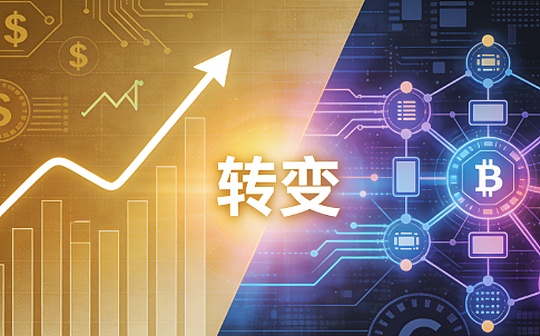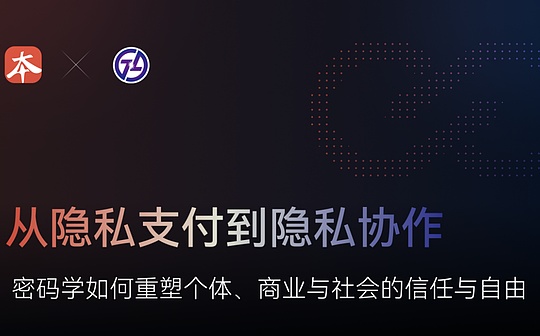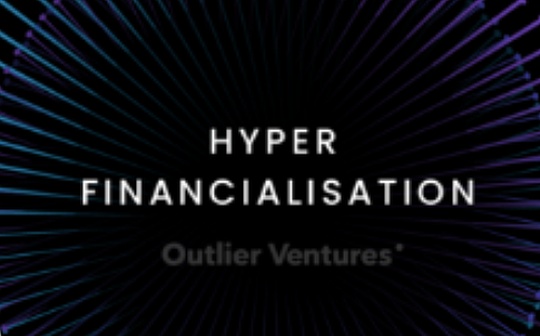
Author: Jasper De Maere, Researcher at Outlier Ventures; Greysen Cacciatore, Associate Researcher at Outlier Ventures; Translated by: 0xjs@Bitchain Vision
Key points of this article:
-
The $Trump token embodies the convergence of politics, finance and culture, confirming the mainstream significance of cryptocurrencies.It emphasizes that the financialization of non-financial assets is a cultural phenomenon that reshapes social structure.
-
Financialization has dominated businesses through derivatives and securitization for decades, and is now spreading to the individual and cultural fields through tokens.
-
We believe thatThere are three driving factors behind super financialization and finance becoming the core part of culture.They are:
-
Technology – The digital revolution makes financial markets accessible and innovative.
-
Education—The younger generation has the richest financial knowledge.
-
Spirit – In today’s spirit of the times, financial success determines personal and professional achievements.
US President issues TRUMP tokens
The net impact of $Trump tokens on the wider ecosystem is unclear, and the president-elect’s launch of memecoin a few days before the inauguration was striking to say the least.It represents a major moment at the intersection of politics, finance and culture.It cements the token’s position as a new category of liquid assets and a tool for participation, fundraising and building influence at the peak of global influence.
In addition to confirming the mainstream relevance of cryptocurrencies,This move also highlights the profound cultural phenomenon of the increasing financialization of non-financial assets.By transforming intangible concepts such as identity, community and influence into tokenized assets, it shows how tokens intertwin finance, technology and culture.This marks a moment of change in redefining social structures and how we participate in value.
We call it super financialization, which we have also discussed in detail in recent research on Post Web.In the post-network, improvements in technology and financial infrastructure will increase the financialization of individual assets, making them more liquid and profitable.This will fundamentally reshape the way value is stored, acquired and utilized.
Not the first time
We have seen financialization happen in the business world before.Over the past 40 years, financialization has transformed the economy by transforming corporate balance sheets into speculative value engines.In the 1980s, deregulation and tools such as derivatives, securitization and global credit markets allowed companies to unlock value from financial engineering rather than production.As businesses increasingly use financial instruments to maximize shareholder returns, non-bank financial assets as a percentage of GDP soared from 40% to over 200% (see Figure 1).This transformation marks the arrival of a new era where the economy is no longer driven by tangible goods and services, but more driven by the monetization of abstract financial assets.
Figure 1: The proportion of assets of non-bank financial institutions in the United States to GDP
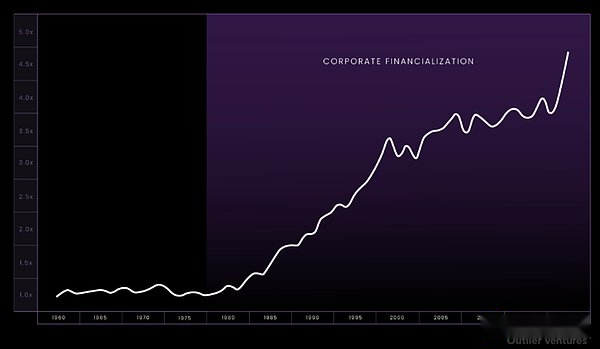
Similar to a company, individuals also have balance sheets (i.e. their property).Tokens and cryptocurrencies are now bringing financialization to the consumer level.Just like derivatives and securitization in the 1980s, innovations such as tokenization and DeFi allow individuals to gain more value from their own assets.However, unlike the 1980s, cryptocurrencies went further, bringing finance and culture together, and like memecoin, tokens can represent identity, community and participation.However, very similar to derivatives, these new tools, emerging as tokens, have inherent risks that we have witnessed first-hand as the framework for managing them continues to evolve.
Spirituality, education and technology
The following section in Chapter 2 of the Post-Internet Age elaborates on what we consider the key drivers behind hyperfinancialization.
The trend of financialization of daily necessities is becoming increasingly obvious, and we call this phenomenon “super financialization”.This socio-cultural transformation allows assets that are not traditionally considered financial, especially intangible assets, to quantify in the form of money and to utilize them to achieve maximum financial gain.This trend of monetizing daily assets will drive the adoption of blockchain technology.These assets become more economical through tokenization, providing an attractive return on investment.
We believe there are three key drivers behind today’s hyperfinancialization, namely (i) education (ii) spirit and (iii) technology (see below).
Figure 2: Three major drivers of social superfinancialization
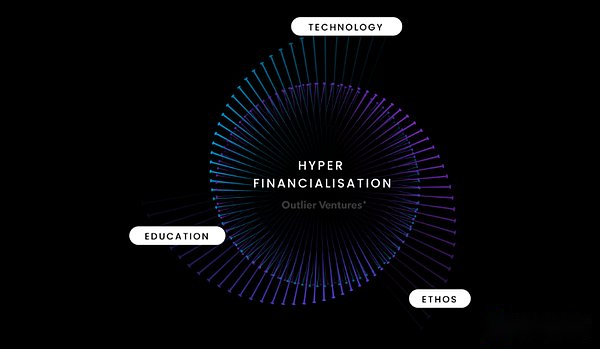
Source: Outlier Ventures
1. Education
Education gives individuals a knowledge of understanding the financial market and its importance.Today’s younger generations, especially Gen Z and Alpha, are the most financially knowledgeable generations in history, thanks to their early exposure to digital technology and “DIY” online resources.LLM and agents further narrow the financial knowledge gap, allowing individuals of any language around the world to receive education, thereby making informed decisions on savings, investing and managing debt or asset, which we believe is the rise of the “100x individuals” and the global population.Improvement of civilization level paves the way.
Figure 3: Left picture – Comparison of education levels among generations.Picture on the right – Source of education for generations.
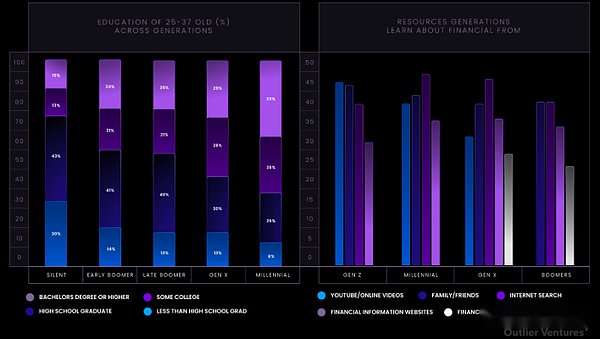
Source: Pew Research Center, Outlier Ventures
2. Spiritual
Spirit, or the collective values of a generation, shape the desire to participate in the financial market.existIn the spirit of today’s era, financial success is closely related to personal and professional achievements.The society’s evaluation of financial success drives the desire to explore and participate in financial opportunities.The spirit of pursuing financial success encourages financialization of the assets you own to maximize the financial potential of personal assets.We are entering an era of extreme capitalism, where financialization will penetrate more into every aspect of our lives than ever before.
3. Technology
Technology is crucial, it bridges the gap between financial knowledge, willingness to participate, and actionable financial opportunities.The digital revolution makes financial markets and assets more accessible, allowing individuals to participate freely.Financial applications not only democratize access to financial markets, but underlying technologies are also changing the types of financial products we provide and abstracting the complexity of financial products.
Technology is changing financial markets in three interrelated ways
1. Democratic visits
The democratization of financial services has changed the financial landscape, made financial tools and platforms widely popularized, and lowered the threshold for individuals and non-qualified investors.This trend promotes financial inclusion, expands market participation, and rapidly expands the potential market for financial products.
Figure 4: TAM (potential market size) for stock trading and investment.The growth of TAM means an increase in service activity and number of users.

Source: Vision, Outlier Ventures
2. New financial products
Technology enables investors to access more complex services and markets.For example, blockchain-based systems unlock decentralized and tokenized finance, completely changing the way individuals manage financial assets.The intersection of technology and finance has promoted the innovation of consumer finance and investment products.
Figure 5:The timeline of the evolution of financial technology over the past 60 years shows that financial services and products have grown exponentially due to the development of technology.
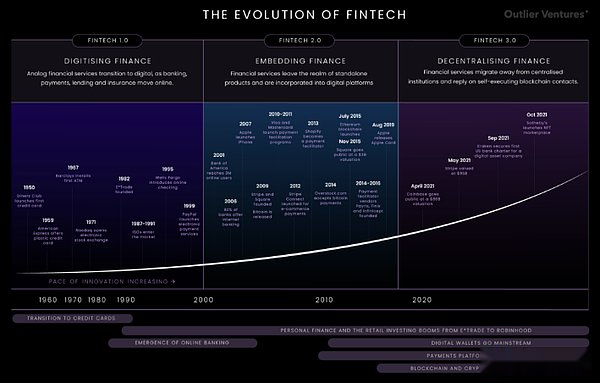
Source: SVB, Outlier Ventures
3. Complexity abstraction
Abstraction is promoting the popularization of new financial products, and through technologies such as complex algorithms, robot consultants and AI-driven platforms, ordinary users can conduct consumer finance and investment more intuitively.This simplification is driving the rapid growth in adoption of financial services and investment opportunities, as trends such as embedded finance and buy-to-pay-and-pay-to-pay-to-pay-to-pay-to-pay-to-pay-to-pay-to-pay-to-pay-to-pay-to-pay-to-pay-to-pay-to-pay-to-pay-to-pay-to-pay-to-pay-to-pay-to-pay-to-pay-to-pay-to-pay-to-pay-to-pay-to-pay-to-pay-to-pay-to-pay-to-pay-to-pay-to-pay-to-pay-to-pay-to-pay-to-pay-to-pay-to-pay-to-pay-to-pay-to-pay-to-pay-to-pay-to-pay-Figure 6 shows that more complex products such as BNPL are mainly adopted among young, tech-savvy generations.
Figure 6: Adoption of BNPL and embedded finance shows rapid adoption.
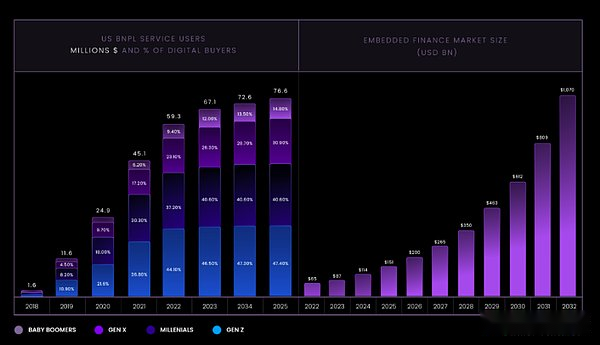
Source: Insider Intelligence, Outlier Ventures
Therefore, the transaction volume of the modern economy is rapidly evolving.In addition to super financialization, society is becoming increasingly transactional.Digitalization allows for finer granular transactions, thus changing the way we pay for services.For example, as digital platforms improve payment tracking, software evolved from prepaid purchases to subscription models.Distributed ledger technology is another upgrade that enables Web3 services such as DePIN to implement a pay-as-you-can-eat model.
Super financialization in the post-network era
As the post-network era accelerates hyperfinancialization, it becomes crucial to resolve the gap in financial knowledge and execution.People with these two skills will participate in the economic cycle, increase wealth, and actively participate in the tokenized economy to become shareholders.With the massive tokenization of assets, post-network era LLMs and agents play a transformative role, leveling the playing field by giving everyone basic financial knowledge and participation.These tools enable individuals to manage and utilize their tangible and intangible assets, ensure wider access to economic opportunities and reduce gaps in wealth and knowledge.

